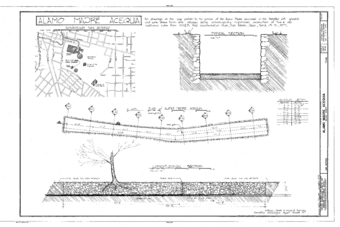Acequia Madre de Valero (San Antonio) facts for kids
|
Acequia Madre
|
|
|
U.S. Historic district
Contributing property |
|

HAER drawing of the acequia
|
|
| Built | 18th century |
|---|---|
| Architect | Antonio de Olivares Payaya people |
| Part of | Alamo Plaza Historic District (ID77001425) |
Quick facts for kids Significant dates |
|
| Designated CP | July 13, 1977 |
The Acequia Madre de Valero was a very important water canal built in the 1700s. It's located in San Antonio, a city in Bexar County, Texas. This special canal helped bring water from the San Antonio River to farms and people. It was a big deal because it allowed people to grow food and live in the area.
Contents
What is an Acequia?
An acequia (say: ah-SEH-kee-ah) is like an old-fashioned ditch or canal. It's built to carry water from a river or stream to places that need it. People use acequias to water their crops or to get water for their homes. They are a clever way to manage water, especially in dry places.
Building the Acequia Madre
The Acequia Madre de Valero was built by the Spanish and the Payaya people. In 1718, Martín de Alarcón started San Antonio for Spain. At the same time, a Franciscan priest named Antonio de Olivares worked with the Payaya people. Together, they dug this acequia by hand.
It was very important for the missions, like the San Antonio de Valero Mission. They needed a way to get water from the San Antonio River. This water was used to grow crops and to supply everyone living there.
Where Did It Go?
This acequia was the first part of a much larger water system. The Acequia Madre de Valero started near an area now called Brackenridge Park. From there, it flowed south. It went all the way to what is now Hemisfair Plaza and South Alamo Street. A part of it even runs hidden beneath the Menger Hotel.
Restoration and Recognition
In 1968, the acequia was fixed up and made new again. That same year, it was named a Recorded Texas Historic Landmark. This means it's a special place that helps tell the story of Texas.
The Bigger Picture: A Whole Water Network
The Acequia Madre de Valero was just the beginning. It became part of a huge 45-mile network of acequias. Franciscan priests built this whole system. Their goal was to provide water for all the missions and their farms.
Clever Engineering
The acequia was built with native limestone. This shows how skilled the Spanish engineers were. Later, German immigrants also helped build parts of the network. They added more stonework to the system.
The complete network included dams, canals, and special gates called sluice gates. These gates helped control where the water went. This amazing water system served the people of San Antonio for a long time. It was used until the late 1800s.
Today, you can see a historic marker for the Acequia Madre de Valero. It's on a limestone block at Hemisfair Plaza. This marker helps people remember its important history.
See also
 In Spanish: Acequia Madre de Valero para niños
In Spanish: Acequia Madre de Valero para niños



